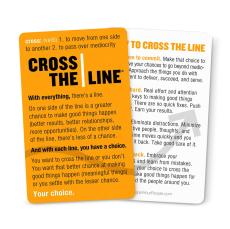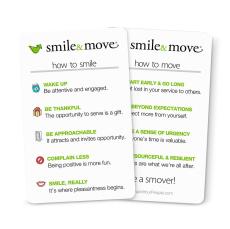Pocket Cards
How to Use Motivational Pocket Cards
13 quick conversations to raise awareness of what it takes to make a better day ... for all of us.
Share them with your team and discuss the ideas.
Ideas to use the cards to kick off or set the tone for a meeting are below along with thoughts on how to use them for a quick 1-on-1 coaching session.
Other uses...
- Include one as a bookmark with a book to reinforce its core message (a 212 pocket card with a 212 book) or add a supporting message (a Rise & Reach pocket card with a Cross The Line Book).
- Attach one or two to other meeting and event handouts, pay stubs, or internal mailings.
- Incorporate them into your hiring efforts or onboarding packages. (We're Smovers here. The points on this card are important to us and to our customers. A Smover is someone who Smiles & Moves.)
Using the cards with a group…
If people will be sitting, you could place a card at each attendee's seat for their arrival. If you're leading a quick standup meeting, you could hand a card to each attendee before starting.
Then you could use language similar to the following…
- "Last week, I found [an idea, a set of ideas, a message] I think can help us see things in a different way … helping us [push things a little more, bounce back faster, stay focused on what's most important, avoid complacency, create a kinder environment, make a stronger commitment to what we're trying to accomplish, embrace our personal responsibility to making things better, be more supportive to each other, lead our teams better, insert other internal need].
- "The [idea, set of ideas, message] is/are on the cards [in front of you, you have in your hand]. It's called/about [insert title or topic]."
At this point, you could read through the card out loud or have someone else read the card. Then, after a short pause so people can absorb what's just been said…
- "Who can share what connects with them most about [this message, these ideas]?"
To encourage discussion, wait for someone to respond. Avoid leading or prompting the first response. Once the ball is rolling, use one or two of the following questions to continue the discussion (or a favorite question of your own).
- "Anyone else have a different point they found meaningful?"
- "Do you think our [customers, clients, co-workers, patients] would describe us as [212ers, Smovers, people who are committed to doing great work for them, a no drama team, etc.]? Why? Why not? What could we do to support that? What could we do to improve that?"
- "When things get difficult and we make mistakes in our efforts to [general message or specific point], what are some things we can do to get back on track? How can we help each other be accountable to [general message or specific point]?"
Using the cards for a quick 1-on-1 coaching session…
Give someone a card and review it with them, personalizing the previous statements and questions for a group. For example…
- "I found [an idea, a set of ideas, a message] I think can help you see things in a different way … helping you…"
- What connects with you most about [this message, these ideas]? Anything else?"
- "Do you think y/our [customers, clients, co-workers, patients] would describe you as a [212er, Smover, person who is committed to doing great work for them, a no drama person, etc.]? Why? Why not? What can I do to support that? What could you do to improve that?"
- "When things get difficult and you make mistakes in your efforts to [general message or specific point], what are some things you can do to get back on track? How can I help you be accountable to [general message or specific point]?"
How ever you use our pocket cards, remember…
The need for solid and ongoing reinforcement never (ever, ever) ends. (It's part of Leading Simply.) Make sure to set periodic reminders to follow up with people about how things are going in regard to your initial discussion (at least one to three).

Reenforce & Engage Your Team
Thousands of leaders in all types of organizations and industries use our messages to help them better communicate important ideas in more interesting ways … ways that lead to positive actions that stick and sustain.
sustain: (verb) strengthen or support physically or mentally
For many of our customers, our videos, books, and do-it-yourself PowerPoint® presentations are the most effective tools for introducing and discussing our messages (212, Lead Simply, Smile & Move, etc.). But, our pocket cards make great additional reinforcement tools for different situations.
Post Meeting Review & Reflect
Do I deliver? Do others enjoy working with me? Am I growing?
So many details in those three questions. But, if you had to sum up what defines our professional value, I believe that's it. (Who wants to be an unpleasant, stagnant teammate who doesn't make good things happen for other people?)
Review & Reflect is a real-world uncluttered framework for evaluation. Its simplicity encourages regular review and reflection ... inspiring better self-awareness and meaningful professional growth ... all with the intent to create those better results and more enjoyable days we're all looking for.
Cost-effective. No software, apps, or consultants needed.
So many ways to use the message with your team. Below is one way I'd introduce and discuss the ideas in a quick informal meeting using the Review & Reflect pocket cards. If it was a remote meeting, I'd mail one to my team ... maybe with a Thanks for Making Good Things Happen note card ... and then discuss it on a call.
It's a Friday, late afternoon (could be any day or time). You invite everyone to come together, standing or sitting.
I came across this idea I think might be very helpful to each of us ... as a team here, for each other ... and also personally throughout our individual careers ... wherever we might find ourselves.*
Handing a stack of pocket cards to someone...
It's called Review & Reflect. Please take one of these and pass the stack around so everyone gets one.
Once everyone has a card...
I believe it's important to regularly pause and think about how we're doing as teammates.
What I like about this message is how simple it is. Jennifer, could you read for us the definitions of review and reflect that are on the front of the card?
Jennifer reads them.
For me, I like the nuances of each of these definitions.
Review is not just to evaluate or observe something … it's to do it with the intent to improve something ... to improve where possible.
Reflect is not just a reminder to think about something, it's also to do it deeply and carefully. This is something I know I haven't done enough of in my life. But reading this ... in this way ... I intend to make it something I do regularly and I'm starting this weekend.
Next week, I'd like everyone to invest 30 minutes or so ... during the workday* or whenever you'd like ... and give attention to the questions on the back of the card.
They'll likely flip the card...
Mike can you read just the 3 headline questions for us?
Mike reads them.
At this point in my career, I think the answers to these questions ... when answered objectively ... can tell us how we're doing professionally ... even personally. And after the first more significant investment of time ... that first 30-or-so minutes ... it can be a simple ongoing way to check ourselves at the end of each week ... maybe even every day.
It's important to remember though, the key is objectivity. We need to be sure not to coddle ourselves in our review of things. In the long run, truth will help us enjoy so much more.
( coddle: to treat yourself in an indulgent or overprotective way )
At this point, the variations of what to do next are endless.
More Ideas for Reenforcing & Engaging
If you have a smaller group that's tight with each other (a group that Loves Their People), you could plan a discussion for the following Friday afternoon where everyone shares notes on their personal evaluations and then accepts open evaluations of those notes from others during the meeting. Pretty bold.
If your team isn't that tight with each other (yet), you could let people know you'll be talking with them individually around their thoughts (because you Lead Simply which means you Connect regularly with your team).
You could reference the Review & Reflect pocket card in a follow-up meeting and then introduce one of our other messages that fit your team development needs...
“Now that we've all had a week to self-assess where we are ... to Review & Reflect ... I'd like to introduce a new message I think can help us with that 'improve where possible' definition within Review. It's called [212, Smile & Move, Cross The Line, Lead Simply].”
For those who've already introduced Lead Simply to their leadership teams, you could follow up that introduction with a quick discussion like the one above; suggesting it as, “Something we can first Model ourselves as leaders … regular self-evaluation and reflection. And then, we can introduce it to our teams so we all can enjoy more of this experience we call life.” (That might be a bit dramatic for some. Work it how you'd like. But, consider keeping the ‘enjoy more' as a more inspiring and less cliché corporate message.)
For those about to introduce Lead Simply to their leadership teams, you could include this message at the same time and then put the pocket card in each book as a bookmark.
Reminder…
At Successories, we eat by creating these messages for you and we still need to remind ourselves of our personal need for solid and ongoing reinforcement (that never ever ends).
Additional Notes…
Regarding the ‘wherever we might find ourselves' statement in the meeting script…
Not everyone is comfortable talking about this. But, the likelihood of a team member staying on the team forever is pretty small. Letting your people know you're sharing this for their improvement no matter where they are in the future, is likely more inspiring than if you make it about only you and the organization. (How good will it be when you're remembered as a better part of someone else's career?)
Regarding using time during the workday for the review…
This might help people understand how valuable you believe this practice is for the team and your organization.











